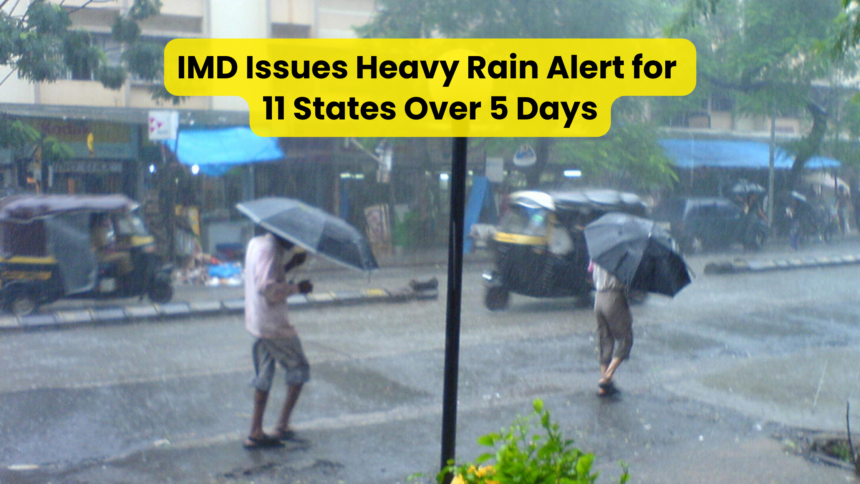Introduction
Monsoon season in India brings a sense of relief and rejuvenation to a nation often scorched by summer heat. However, it also heralds periods of heavy rainfall that can significantly impact daily life and infrastructure. The India Meteorological Department (IMD) has issued an alert predicting heavy rain in 11 states over the next five days. This forecast is crucial for preparation and safety, guiding both authorities and the public.
Overview of IMD Alert
Purpose of the Alert
The IMD alert serves as a preemptive warning aimed at mitigating the adverse effects of the anticipated deluge. By informing the populace in advance, the IMD ensures that measures can be taken to protect life and property.
Regions Affected
The states under this alert span various geographical and climatic zones, showcasing the extensive reach of the upcoming monsoon rains. These include Maharashtra, Kerala, Gujarat, Madhya Pradesh, Chhattisgarh, Odisha, Jharkhand, West Bengal, Bihar, Uttar Pradesh, and Uttarakhand.
Monsoon Advancements
Early Movements
The southwest monsoon made an initial push into the southern parts of Gujarat early in June. This early movement set the stage for the broader spread expected to continue over the coming days.
Current Progress
As of now, the monsoon has advanced further into key regions such as Maharashtra, Gujarat, and parts of Madhya Pradesh and Chhattisgarh. This advancement aligns with the IMD’s predictions and highlights the dynamic nature of the monsoon season.
Detailed State-Wise Forecast
Maharashtra
Maharashtra is set to receive substantial rainfall, particularly in the Konkan and Goa regions, as well as the Ghat areas of Madhya Maharashtra. This rainfall will be crucial in replenishing water resources but may also lead to flooding in low-lying areas.
Kerala
In Kerala, the monsoon is expected to bring heavy downpours, especially in coastal and midland regions. This is a typical pattern, yet the intensity this year necessitates caution due to potential landslides and waterlogging.
Gujarat
Gujarat, having seen an early onset of the monsoon, is forecasted to receive continuous rain, particularly in southern districts. This will benefit agriculture but may disrupt daily life in urban centers like Ahmedabad and Surat.
Madhya Pradesh
Madhya Pradesh, struggling under heatwave conditions, will experience a significant shift with the arrival of the monsoon. This rain will be widespread, accompanied by thunderstorms and lightning, necessitating preparedness against potential storm damage.
Chhattisgarh
Similar to Madhya Pradesh, Chhattisgarh will benefit from widespread rainfall, easing the heat and aiding agricultural activities. However, the intensity of the rain might pose challenges to infrastructure and daily activities.
Odisha
In Odisha, the monsoon’s progress will bring much-needed rain, particularly benefiting paddy cultivation. However, heavy downpours might lead to flooding in riverine areas.
Jharkhand
Jharkhand will see substantial rainfall that will support agriculture but might disrupt mining activities, which are pivotal to the state’s economy. Precautionary measures will be essential to mitigate any adverse impacts.
West Bengal
West Bengal, particularly the coastal and Gangetic plains, will experience heavy rainfall. This will aid agriculture but might cause waterlogging and affect urban infrastructure in cities like Kolkata.
Bihar
Bihar’s forecast includes heavy rain, which is crucial for the Kharif crop season. However, the state’s flood-prone areas need to be vigilant to avoid severe flooding scenarios.
Uttar Pradesh
Uttar Pradesh will receive widespread rain, crucial for both agriculture and water reservoirs. The rainfall, however, might lead to urban flooding in densely populated areas.
Uttarakhand
In Uttarakhand, heavy rainfall is expected, especially in hilly regions, increasing the risk of landslides and flash floods. Precautionary measures and alerts are crucial for ensuring safety in these vulnerable areas.
Impacts of Heavy Rain
Agriculture
The monsoon rains are a boon for agriculture, replenishing water tables and ensuring crop health. However, excessive rainfall can damage crops and delay harvesting.
Infrastructure
Heavy rains pose significant challenges to infrastructure, including roadways, bridges, and buildings. Flooding and waterlogging can disrupt transportation and daily activities.
Daily Life
Daily life is often significantly disrupted by heavy rainfall, affecting commuting, work, and school activities. Proper planning and adherence to safety measures are essential during such times.
Preparedness Measures
Government Initiatives
Governments at state and local levels are implementing various measures, including drainage system maintenance, emergency services readiness, and public advisories to handle the anticipated heavy rainfall.
Public Safety Tips
Residents are advised to stay informed through reliable sources, avoid flooded areas, and ensure their homes are secure against potential water damage. Emergency kits and evacuation plans are also recommended.
Historical Monsoon Patterns
India’s monsoon patterns have shown variability over the years, with some regions experiencing increased rainfall while others face deficits. Understanding these patterns helps in better preparation and response.
Role of the India Meteorological Department
Monitoring
The IMD plays a pivotal role in monitoring weather patterns using advanced technology and data analysis, ensuring accurate and timely forecasts.
Forecasting Techniques
The IMD employs a combination of satellite imagery, weather stations, and computational models to predict weather patterns and issue alerts, providing crucial information to the public and authorities.
Climate Change and Monsoons
Changing Patterns
Climate change is influencing monsoon patterns, leading to unpredictable and extreme weather events. These changes necessitate adaptive strategies to cope with new challenges.
Future Projections
Projections indicate that monsoon patterns will continue to evolve, with potential for more intense and irregular rainfall. This underscores the need for robust forecasting and preparedness frameworks.
Conclusion
The IMD’s alert about heavy rainfall in 11 states over the next five days highlights the importance of preparedness and responsive action. By understanding the forecast and taking appropriate measures, we can mitigate the impacts of these weather events and safeguard lives and livelihoods.
Follow Humstory for more content.













